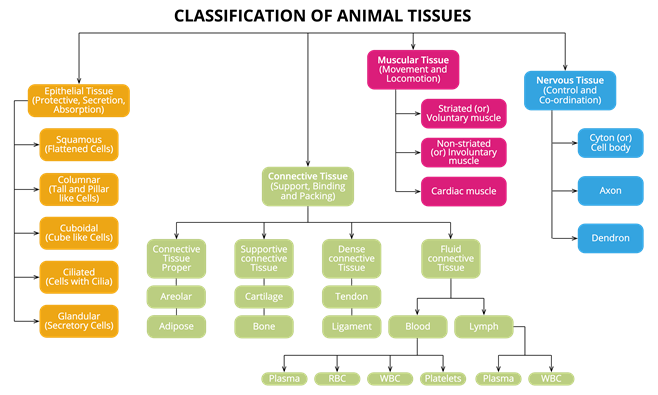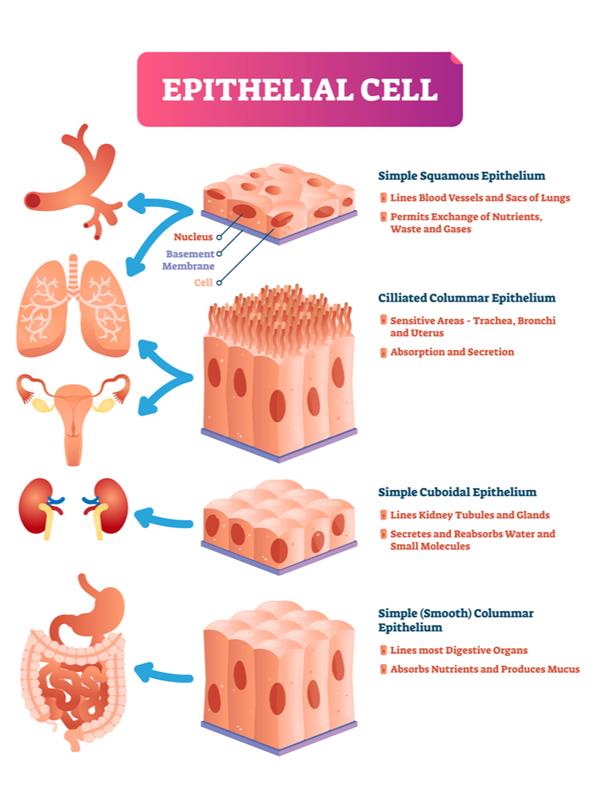
PUMPA - SMART LEARNING
எங்கள் ஆசிரியர்களுடன் 1-ஆன்-1 ஆலோசனை நேரத்தைப் பெறுங்கள். டாப்பர் ஆவதற்கு நாங்கள் பயிற்சி அளிப்போம்
Book Free Demo
Classification of animal tissues
Epithelial tissue:
Think about what will happen if we don't have skin? All our internal organs will be exposed to the environment and will be in danger situation. This condition is because the environment can create damage or injury to all our internal organs.
Skin is acting as a protective layer, which protects our internal organs from the external environment. The skin comprises a special type of cells called epithelial cells, and skin is an epithelial tissue. Various parts of the body contain this epithelial tissue.
Example:
The small intestine has epithelial tissue that helps in absorption, epithelial tissue in the lungs helps in the exchange of gases, epithelial tissue in kidney tubules helps remove nitrogenous wastes.

Different types of epithelial cells
The word epithelium was coined by Frederik Ruysch. The covering or protective tissue in the animal body is epithelial tissue. Epithelial cells evolved first and are also first formed cells in the embryo. This tissue arises from all the three forms of germ layers: ectoderm, endoderm and mesoderm of the embryo.
It is the simplest protective tissue of the animal body.It is composed of one or more than one layer of cells that form membranes. It protects the body surface and the internal organs. The cells are arranged very close to each other with minimum extracellular material.
It lies on a non-cellular basement membrane. The epithelium is separated from the underlying tissue by an extracellular fibrous basement membrane containing collagen. It is a structural protein. Epithelial tissue contains no blood vessels, and hence it is known as non-vascular. It covers the surfaces and lines the cavities of organs. Therefore they are sometimes called surface tissues.
It creates a barrier to keep different body organs separated from each other. In epithelial tissue, cells are tightly packed and create a continuous sheet. They have almost no intercellular spaces with only a tiny amount of cementing material between them. Underlying connective tissue separates the epithelium, and it helps to provide the nutrients.
Any material which enters or leaves the body has to cross at least one layer of epithelium. So permeability of various epithelial cells is very important in exchanging materials between the body and environment and other parts of the body.
Location: It is found in the skin, lining the buccal cavity (mouth), blood vessels, organs in the alimentary canal, digestive glands such as the pancreas and liver, lung alveoli and kidney tubules.
Types of epithelial tissue: Based on the shape of the cells and their arrangement, epithelial tissues further classified as follows:
Simple epithelium: It is consist of a single layer of cells, which is resting on the basement membrane.
Compound epithelium: It is made up of numerous layers of cells. The deepest layer of the cells only rest on the basement membrane. They protect the underlying tissues from drying, injury and microbial infections.
Functions of epithelial tissues:
- Protection: The skin is the outermost covering of the body, and it is made up of epithelial cells. Inside the body, the lining of the oral cavity and the alimentary canal is made up of epithelial cells, which gives protection to the organs and glands. Epithelial tissues acts as the waterproof membrane in the skin.
- Absorption: Line of epithelia found in the intestine help in the absorption of water and nutrients.
- Respiration: Epithelium of lungs alveoli regulates the exchange of oxygen and carbon dioxide between blood and lungs.
- Secretion: Epithelial lining in the cavities gives rise to glands that provide various biochemical substances secretions such as sweat, saliva, mucus, gastric juice, which contains enzymes.
- Excretion: Epithelial lining, which is present in kidney tubules, helps to eliminate nitrogenous waste materials as urine.